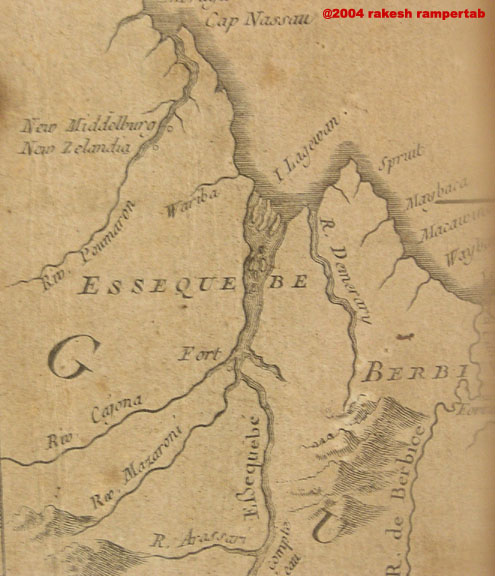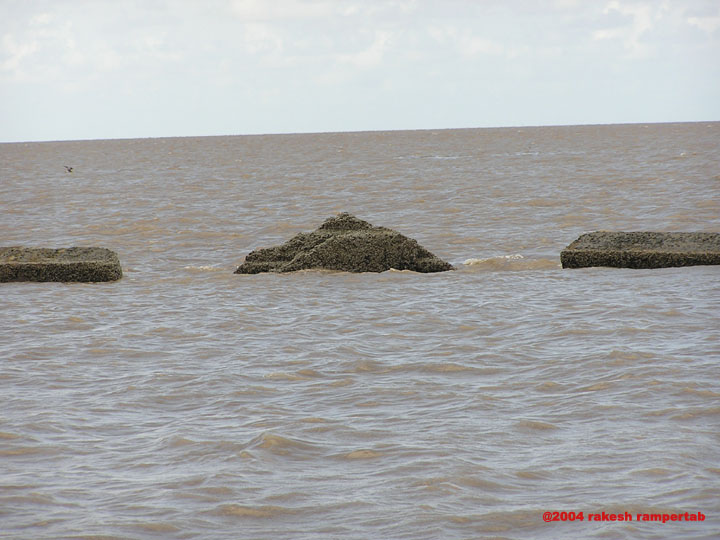| by Rakesh Rampertab |
“The whole of this land is
formed by the mud which has been brought down by these great rivers…”
“From Pakaraimas’ peaks
of power…” After centuries, the Amerindians are still correct. Guyana is a “land of many water” that was created, if only partially, out of the ocean and its brown Amazonian rivers. For centuries, it or its coastal plain has been described in relation to water. The English historian, James Rodway, speaks of cultivated land as being “the scene of a struggle with the sea in front and the flood behind.” And in the same late nineteenth century, Anthony Trollope, the English writer tells us in his West Indies and the Spanish Main of its hospitable peoples and large sugar industry, in great contrast to the villainous reputation Guiana had earned for herself; “There never was a land so ill spoken of…,” a land apparently described as a “low, swampy, muddy strip of alluvial soil, infested with rattlesnakes…” He also writes of the mosquitoes and marabuntas, and of the flatness of the country; “The country certainly is flat…the eye meets no rising. Everything stands on the same level.” When the Dutch and British first began to cultivate the verdant coastal strip of Guiana, the task of resisting the sea from the front and the flood water from behind was a task to contend with. In a book that was written under the auspices of Forbes Burnham, the Guyanese historian and old school master, Mr. Vere T. Daly, writes in A Short History of the Guyanese People that these early settler-planters “inherited not a stable situation but a very unstable and complex one.” The resulting plan to manage this “unstable” situation involving arable lands amounted to “a sea-wall at the front to keep out the sea at high tides, a dam at the other end to keep out swamp-water…with a sluice to permit of the discharge of accumulated rain water into the sea at low tide if necessary” (Raymond T. Smith, historian and sociologist, British Guiana, p 6).
Guyana, more or less, belongs to the ocean and
the rivers and this is why the Amerindians were correct in naming
this dangerous locale. The ocean refuses to renounce the area,
flooding it at high tides throughout the centuries (such as in
1855, swamping the Kingston area, and along the East Coast in
1934), constantly eroding the shoreline. A look at any old map
from as late as two hundred years ago will show a coastline that
once protruded into the ocean (see left).
It is this extended landmass, under the pressure of the ocean
that the Dutch attempted to rescue with their extraordinary engineering.
Where the Romans departed with aqueduct, the Dutch constructed
sea-walls. Today, the melting of the colossal ice masses in temperate world regions and global warming resulting in unusually unpredictable weather patterns, add unprecedented pressure to this flat alluvia coastal landscape. And these, in addition to neglect and improper drainage and maintenance, primarily under local village councils, are essential parts of the story of the January 2005 flood. Irrigation and Distrust The safety of the land was always paramount as is the industry it fostered. But it was never enough, according to historian Smith, to merely cultivate free of the “benefits of a highly scientific agriculture” community, including apt land irrigation. Before the arrival of the draglines, the “shovel men” kept trenches and other waterways clean—under the tutelage of estate management from Bookers to Guysuco. Unfortunately, the closure of several estates nationwide has left villages (e.g., Leonora and Diamond) vulnerable to their sprawling networks of canals (see photo) and drains clogged from vegetation and waste. Historically, drainage maintenance was a controversial
issue between plantation owners and villagers. Newly formed villages
struggled to finance such extensive responsibilities. Thus, despite
protests from plantation owners, this job was transferred (Ordinance
of 1883) by the colony’s governor, Sir Henry Irving, to
the Public Works Department, placing it directly under the British,
which resulted in the East Demerara Water Conservancy (EDWC) providing
water to the early East Coast villages, while some on the West
Coast received water from the Boerasirie Conservancy.
(Above, old "Dutch" seawall at CI on the West Coast of Demerara. Photo, Rakesh Rampertab.) Hamilton Green, the Basin Villages, and
Pigs In similar vein, two weeks into the flood, government
engineers remarked that the basin villages (Good Hope, Buxton,
et cetera), acquire the most flood water because they are the
lowest of villages. This is nothing new. The two things very common
in this “basin” area are floods from rainfall, and
the sighting of mud-drenched pigs. Interestingly, Mr. Hubert Harper,
an elder originally from Golden Grove, noted that generations
ago, “rangers [village-office] used to run the canals to
ensure that they were cleared. People's pigs never used to be
roaming the streets…” (Kaieteur News, late
January, 2005). [Editor's Note: Please see our Flood Page which includes a number of galleries of relevant images etc.]
|
| February 14, 2005 |
©
2001 Guyanaundersiege.com |
 Guyana
today is the result of thousands of years of erosion, soil attrition,
and invasion of the sea into land. The original remains of Guyana
exist in the hinterland in the ancient mountain ranges such as
the Pakaraimas and Kanuku. Erosion of these ranges have led to
the white sand now common in places as far out as Timehri. The
mud, however, upon which civilizations have now lived and farmed,
was dragged by the rivers from the hinterland as well as pushed
up from the sea, by both water and wind.
Guyana
today is the result of thousands of years of erosion, soil attrition,
and invasion of the sea into land. The original remains of Guyana
exist in the hinterland in the ancient mountain ranges such as
the Pakaraimas and Kanuku. Erosion of these ranges have led to
the white sand now common in places as far out as Timehri. The
mud, however, upon which civilizations have now lived and farmed,
was dragged by the rivers from the hinterland as well as pushed
up from the sea, by both water and wind.  Distrust is everywhere. And while the President of Guyana and
the Leader of the Opposition held hands at a prayer meeting, hands
cannot suffice where trust does not exist. Despite warnings from
the National Drainage and Irrigation Board (NDIB), Mahaica farmers
flood water into an already swollen Mahaica creek. And while NDC
chairmen defended their mandates, civilians such as the General
Secretary of the Guyana Rice Producers' Association, Mr. Dharamkumar
Seeraj, feels betrayed; “But they (drainage officials) are
telling the president that everything is in order and working
well” (SN 1/31/2005). In, parliament, the government refused
calls for an inquiry into the causes of the flood, perhaps to
safeguard the engineering company that was awarded a contract
to repair the EDWC, and has done substandard work resulting in
further destabilization of the dam.
Distrust is everywhere. And while the President of Guyana and
the Leader of the Opposition held hands at a prayer meeting, hands
cannot suffice where trust does not exist. Despite warnings from
the National Drainage and Irrigation Board (NDIB), Mahaica farmers
flood water into an already swollen Mahaica creek. And while NDC
chairmen defended their mandates, civilians such as the General
Secretary of the Guyana Rice Producers' Association, Mr. Dharamkumar
Seeraj, feels betrayed; “But they (drainage officials) are
telling the president that everything is in order and working
well” (SN 1/31/2005). In, parliament, the government refused
calls for an inquiry into the causes of the flood, perhaps to
safeguard the engineering company that was awarded a contract
to repair the EDWC, and has done substandard work resulting in
further destabilization of the dam.